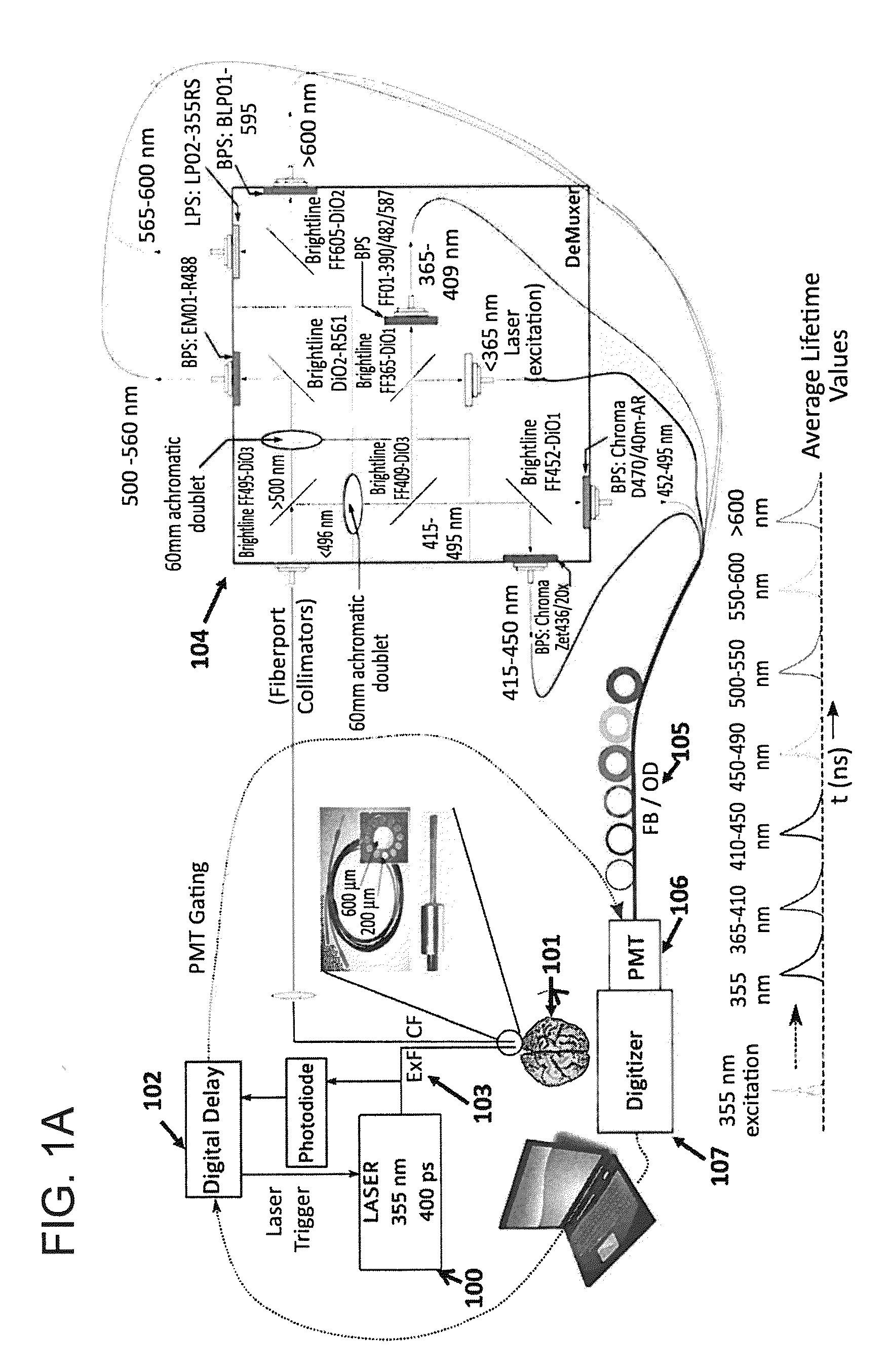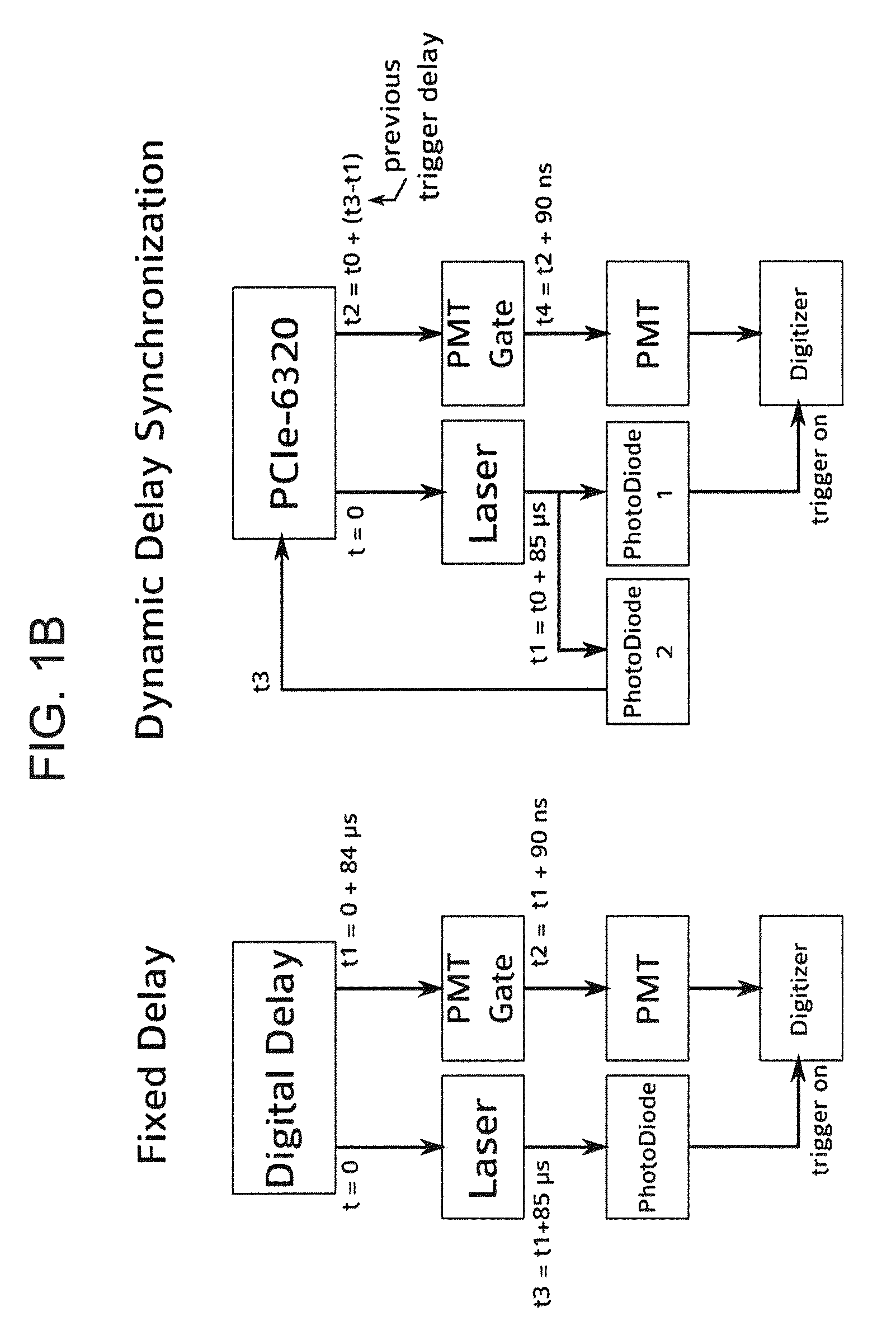Time-resolved laser-induced fluorescence spectroscopy systems and uses thereof
a laser-induced fluorescence and laser-induced fluorescence technology, which is applied in the direction of fluorescence/phosphorescence, instruments, optical radiation measurement, etc., can solve the problems of limiting the effect of real-time measurement, and affecting the accuracy of the overall measuremen
- Summary
- Abstract
- Description
- Claims
- Application Information
AI Technical Summary
Benefits of technology
Problems solved by technology
Method used
Image
Examples
example 1
Continuous Monitoring of Cellular Metabolism
[0050]The systems described herein allow continuous monitoring of the changes in the NADH level at very minute scales to determine changes in metabolic status in response to oxygen depletion, effect of neuro-protective drugs etc. (FIGS. 1 and 5).
[0051]Nicotinamide adenosine dinucleotide (NADH) is involved in redox reaction for ATP production in aerobic respiration. NADH is produced in mitochondrion during glycolysis and citric acid (TCA) cycle. NADH is oxidized to NAD+ at the mitochondrial membrane producing ATP in the process. This process is disrupted in conditions including but not limited to ischemia due to stroke. In a low oxygen condition, NADH accumulates in the cell, and persistent oxygen depletion may result in cell death, leading to complete breakdown of NADH. These variations in NADH level allow assessment of viability and vulnerability of cells in ischemic condition. Fluctuations in NADH levels may be evaluated by measuring the...
example 2
Determining Tissue Viability after Injury
[0055]Recording the NADH levels over a large area of brain after an ischemic stroke permits assessment of the number of viable cells that may be in shock due to lack of oxygen, but may not have undergone apoptosis and thus are salvageable. These cell form the bulk of the region known as the penumbra and an important goal of stroke treatment is to reduce the size of penumbra while salvaging as many neurons as possible. Monitoring NADH over the entire penumbra region allows assessment of the effectiveness of various interventions designed for the same.
[0056]In order to excite the tissue, a Q-switched Nd:YaG laser emitting at a wavelength 350 nm was used, running at 1 KHz with a pulse width (FWHM) of 400 ps (Teem Photonics PNVM02510). Total energy per pulse did not exceed 5 μJ which prevented photo-bleaching of NADH. The excitation light was delivered to the tissue using a custom made trifurcated optical probe. The probe consisted of a central 6...
example 3
Use of Fluorescence to Determine the Level of Drug / Metabolite in Plasma
[0059]Some anticancer drugs are toxic at high dosages and lose their efficacy at lower dosages. This optimal plasma concentration of the drug at which the drug is most effective (therapeutic window) varies amongst patients due to variation in height, weight, metabolism and ethnicity. In spite of these variations, currently the drug dosages are calculated based on the weight of the patient and a standardized pharmacokinetic profile. A quick and inexpensive method to determine the plasma drug level allows optimization of dosages for individual patients. The plasma level of drugs may be detected using fluorescence spectroscopy. It is known that some of the anticancer drugs such as methotrexate have fluorescent properties. Herein Applicants show that using the TRLIFS systems described herein, varying the concentrations of methotrexate (MTX) in agar (FIG. 8) resulted in corresponding change in fluorescence of MTX.
[006...
PUM
| Property | Measurement | Unit |
|---|---|---|
| wavelengths | aaaaa | aaaaa |
| wavelengths | aaaaa | aaaaa |
| wavelengths | aaaaa | aaaaa |
Abstract
Description
Claims
Application Information
 Login to View More
Login to View More - R&D
- Intellectual Property
- Life Sciences
- Materials
- Tech Scout
- Unparalleled Data Quality
- Higher Quality Content
- 60% Fewer Hallucinations
Browse by: Latest US Patents, China's latest patents, Technical Efficacy Thesaurus, Application Domain, Technology Topic, Popular Technical Reports.
© 2025 PatSnap. All rights reserved.Legal|Privacy policy|Modern Slavery Act Transparency Statement|Sitemap|About US| Contact US: help@patsnap.com



